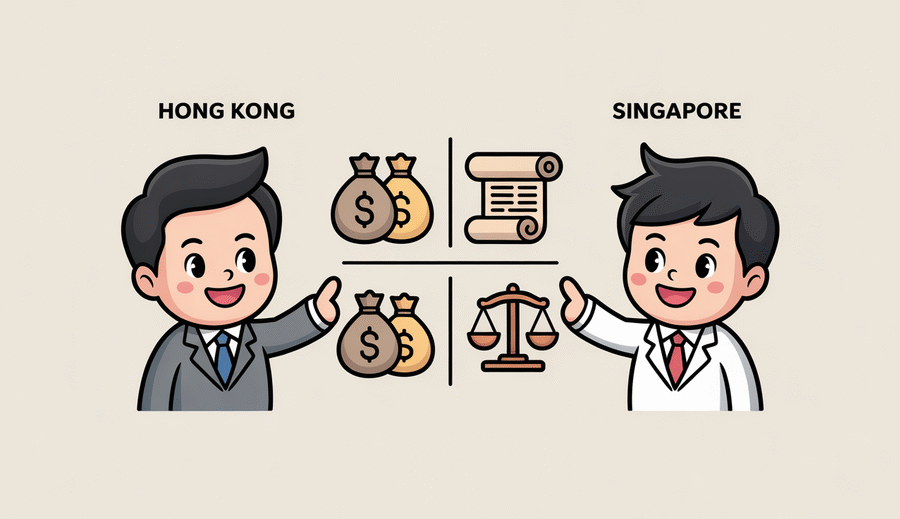Hong Kong vs. Singapore: Positioning as Global Wealth Hubs
Hong Kong and Singapore have long been recognized as Asia’s premier financial centers, locked in dynamic competition to attract and manage significant pools of high-net-worth capital. Their distinct positioning as global wealth hubs is intricately linked to their strategic geographic locations within the Asia-Pacific region, a critical factor for international wealth management structures like trusts holding multi-jurisdictional assets and benefiting global families.
Hong Kong has historically capitalized on its unique proximity to and deep economic integration with Mainland China. It serves as a primary conduit for wealth flowing into and out of the world’s second-largest economy. This strategic advantage provides unparalleled access to the rapidly expanding pool of Chinese wealth seeking international diversification, professional management, and sophisticated structuring, naturally positioning Hong Kong as a preferred gateway for those with substantial ties to the Mainland.
In contrast, Singapore leverages its central position within Southeast Asia and its extensive connectivity to global markets extending beyond Greater China. It has meticulously cultivated an image as a neutral, stable, and globally oriented hub. This positioning appeals to a broader spectrum of wealth holders from across the ASEAN nations, India, the Middle East, and further afield. This wider geographic reach distinguishes Singapore, catering to a more diverse client base compared to Hong Kong’s strong emphasis on the Mainland market. Its perceived neutrality and stability are particularly attractive to international families navigating complex geopolitical landscapes.
Both jurisdictions command significant market share in the region’s trust and wealth management sector, supported by robust legal frameworks and highly sophisticated professional services. While precise comparative data on market share can vary depending on metrics, trends consistently highlight both cities as dominant forces. Their respective strategic alignments naturally influence the origins of the wealth they manage; Hong Kong demonstrates strength in China-linked wealth, while Singapore attracts a wider spectrum of international capital. This fundamental difference in strategic focus and geographic reach is key to understanding their respective strengths and specializations in the global wealth management landscape, particularly in the context of complex, multi-generational trust structures.
| Feature | Hong Kong | Singapore |
|---|---|---|
| Primary Geographic Focus | Gateway to Mainland China | Southeast Asia & Broader International |
| Strategic Alignment | Deep Integration with China | Neutral, Globally Connected Hub |
| Standing in Trust Market | Leading Asian Trust Hub | Leading Asian Trust Hub |
Trust Structure Flexibility and Legal Frameworks
Selecting the appropriate jurisdiction for sophisticated wealth management structures necessitates a thorough understanding of the fundamental legal frameworks and structural options available. Both Hong Kong and Singapore have proactively reformed their trust laws to enhance their appeal to high-net-worth individuals, yet they offer distinct approaches concerning flexibility, control, and longevity that require careful consideration.
A significant distinction lies in the permissible duration of private trusts. Hong Kong’s legislation currently imposes a perpetuity period limit, typically capped at 80 years. While this represents a substantial extension from its historical common law rule, it remains a finite term. Singapore, conversely, has moved towards allowing trusts to exist in perpetuity, meaning they can potentially operate indefinitely. This provides ultra-long-term planning capabilities across numerous future generations without the need for periodic restructuring driven solely by duration constraints.
The extent to which a settlor can retain control over trust assets or administration also differs between the two jurisdictions. Singapore explicitly provides for Reserved Powers legislation, specifically permitting settlors to hold certain powers (such as investment decisions, or the power to appoint or remove trustees) without the trust being automatically invalidated for lack of certainty or control issues. Hong Kong’s 2013 trust law reforms also introduced greater flexibility and codified certain administrative and dispositive powers, making its framework more adaptable to modern trust needs and settlor preferences, although the specific legislative approach and its implications for retained powers differ from Singapore’s dedicated statutory framework.
Furthermore, both jurisdictions have incorporated robust mechanisms designed to protect trust assets from challenging claims originating from foreign legal systems, such as forced heirship rules or certain types of creditor actions. These ‘firewall’ provisions are crucial for international families holding assets across multiple countries, aiming to ensure that the trust structure governed by Hong Kong or Singapore law is upheld against conflicting foreign legal concepts. The specific scope, robustness, and judicial interpretation of these asset protection mechanisms represent another important layer for comparison.
| Feature | Hong Kong | Singapore |
|---|---|---|
| Maximum Trust Duration | 80 years | Perpetual |
| Settlor’s Retained Control | Enhanced flexibility (post-2013 reforms), certain powers can be reserved | Explicit Statutory Reserved Powers regime allows clear reservation of powers |
| Foreign Asset Protection (‘Firewall’) | Strong statutory and common law provisions | Robust statutory protection measures against foreign judgments/rules |
Understanding these structural and legal differences is paramount for tailoring a trust structure that precisely aligns with a family’s unique objectives regarding wealth longevity, desired level of settlor involvement, and cross-border asset protection needs. Each framework presents distinct advantages, making the choice dependent on the specific planning horizon and the settlor’s preferences for ongoing influence and control over the trust.

